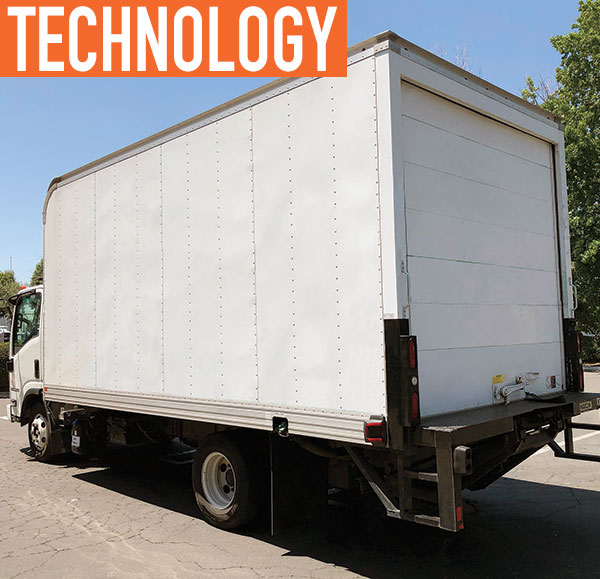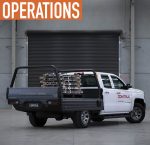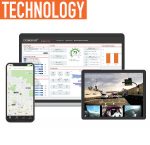One of the most helpful technologies implemented into our automobiles within the past few years is blind spot detection (BSD) systems. This technology uses sensors along the vehicle to detect other vehicles in the driver’s blind spot. Once another vehicle is detected a warning light displays on the side mirrors or on the side panels of the windshield inside the vehicle. Some vehicles include alarms in their BSD systems.
Consumer Reports found that 82% of drivers of BSD-equipped vehicles reported being “very satisfied” with the blind spot warning, and 60% of drivers say the system helped them avoid a crash. With numbers like this, it isn’t likely BSD systems will go away any time soon. In fact, expect OEMs to design more advanced systems and expand to larger vehicles.
BSD systems are great for fleet vehicles that spend a lot of time on four-lane highways and delivering in the city. If your fleet vehicles aren’t currently equipped with a BSD system, a variety of aftermarket systems are available—at least for all of your light-duty vehicles. Fewer systems are available for Class 4-6 vehicles, but they aren’t impossible to find.
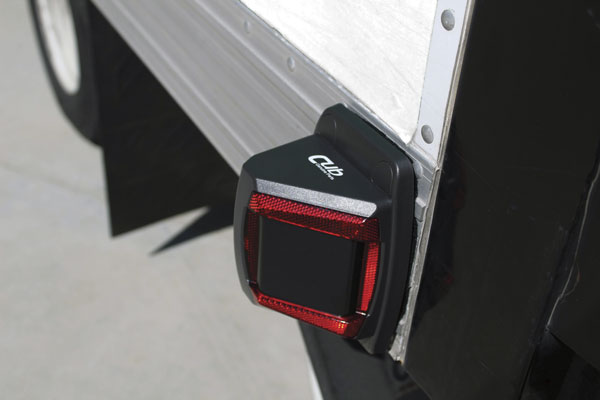
SENZAR BSD
One company’s aftermarket solution can be mounted on just about any vehicle—including motorcycles. Novus Radar Technologies, located in Southern California, designed Senzar, an easily installed BSD system that is great for a variety of applications. Novus Radar Technologies is a branch of CUB Group, a global company focused on designing advanced driver assist system (ADAS) products, tire pressure monitoring system (TPMS) solutions, and electromechanical products since 1979. Senzar adds to its list of ADAS solutions for automotive, recreational vehicle, heavy industry, and commercial fleet environments.
The Senzar aftermarket BSD system kit includes two sensors (one for each side of the vehicle or towable) and two indicator lights or a notification system that suctions to the windshield. It uses radar technology to detect vehicles and motorcycles in or approaching a driver’s blind spot up to 30 ft behind a pickup and 75 ft behind a trailer. If a vehicle or motorcycle is detected in the blind spot or approaching at a high speed, the indicator lamps illuminate to alert the driver of a potential danger.
The system also includes a lane change alert system that corresponds to your vehicle’s turn signals. If a turn signal is activated and the radars detect a possible danger, the driver is alerted through an audible tone and a flashing indicator lamp.
Finally, Senzar’s BSD system includes rear cross traffic detection that activates once the vehicle is placed in reverse. It detects up to 30 ft behind the vehicle and up to 60 ft to the immediate sides of the rear of the vehicle. An audible tone and flashing indicator lights alert the driver once a vehicle is detected.
AVAILABILITY
The Senzar product isn’t available for all models yet—although eventually the brand will expand its offering across all truck Classes. Currently it’s available for any vehicle with an OBD-II. An OBD-II is an on-board computer that features a 16-pin port located under the driver’s side dash of just about all light- and medium-duty vehicles made in or after 2008. This is the exact port used to detect fault codes from the vehicle’s computer.
But what does an OBD-II have to do with blind spot detection? The OBD-II port is where Senzar connects to your vehicle. The Senzar product was designed to be easy to install—in fact, even “DIY,” Augustin Leung, vice president of CUB Group’s ADAS Division, says. Although simple, the installation process is different for pickup trucks versus chassis cabs and medium-duty trucks, however.
INSTALLATION
Senzar for your pickup trucks looks different than Senzar for your chassis cabs, medium-duty trucks, and towables. The Senzar sensor for your pickup truck is located in the truck’s tail light. Each Senzar kit for pickups comes with two model-specific tail lights to replace your truck’s current lights. The Senzar website currently lists 2014-2018 Ford F-150 and Ram 1500 models with available tail lights, although additional makes and models will be available in the future. See the detailed, step-by-step guide for installation to the left.
Installing the Senzar device on a utility body, medium-duty vehicle, or towable is simple and also very similar to pickup installation. However, instead of removing tail lights, Senzar’s radar units are installed on the rear left and right sides of the towable, utility bed, or truck box. Once the radar units are installed, simply route the plug-and-play harness and install and connect the indicator display inside the cab. Install takes approximately two hours.
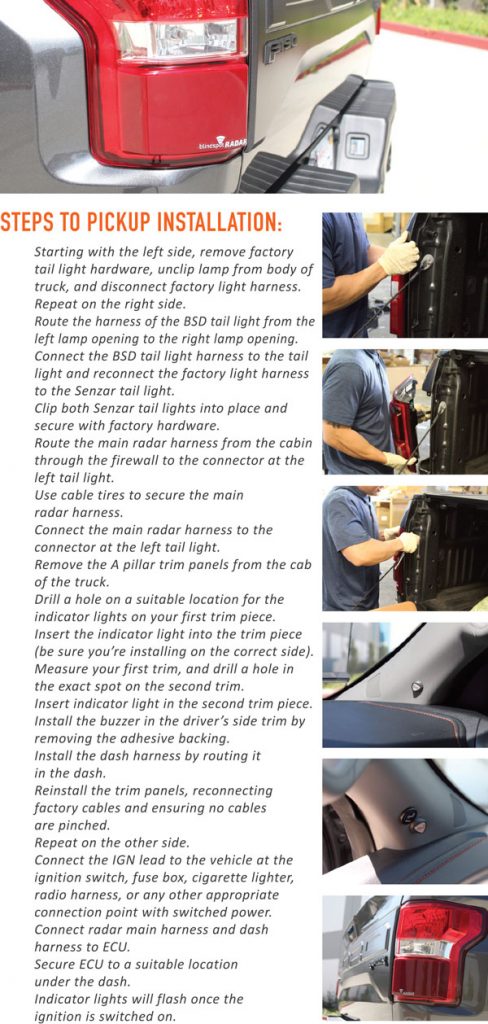
THINGS TO NOTE
Senzar is a relatively new product that is steadily making its way into the field on work trucks. Leung says that fleets have shown interest from online promotions, and so far a produce fleet in LA has given Senzar a test drive. Yet the fleet’s safety manager likes the system so much, soon every vehicle in his fleet will be equipped.
The recreational, motorcycle, and bus adaptations of the Senzar product have been in use for quite some time. However, if Senzar is used on work trucks that owners rely on day in and day out, preventing accidents on a regular basis, drivers experience fewer crashes and less downtime, improving efficiency, Leung says.
Senzar retails for $999 per kit. There are fleet discounts available, as well as installation pricing bundles to eliminate the need for the customer to install the kit on their own. The makers of Senzar recommend potential customers use InstallerNet, where Senzar can be purchased by fleet owners. InstallerNet is available all across the United States and Canada.
Once the kit is installed, customers aren’t left alone to fend for themselves. Novus Radar Technologies handles all tech support in-house. If you have issues with your BSD system, use the support line to connect to a human, not a robot, who knows the product forward and back.
WHY SENZAR?
In the work truck industry, especially for light- and medium-duty trucks and vans, a driver’s primary job is not usually just a driver; they are technicians and tradesmen. Safety products such as Senzar can help drivers save time while going from jobsite to jobsite and help reduce stress on the road, giving drivers peace of mind that they are clear to change lanes or back out of a parked position. Reducing accidents and reducing stress leads to a reduction in driver fatigue, a leading cause of accidents.
Fewer accidents lead to safer drivers and less money spent on vehicle maintenance. But fewer accidents also prevent lawsuits spawned from those accidents. “Reducing liability and improving driver safety is a big thing,” Leung says. But, “not having to pay out deductibles or minimums on lawsuits or accidents … is a huge thing.” And at a price point of $1,000, avoiding just one accident with a Senzar radar system pays for itself, Leung adds.
For more information:
Novus Radar Technologies—maker of Senzar—is engaged in research, development, and design of ADAS, products, TMPS solutions, and electromechanical products for the commercial fleet industry and more. Find out more about Senzar, visit www.meetsenzar.com.


